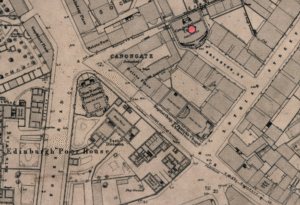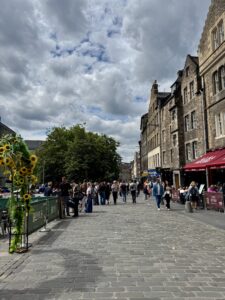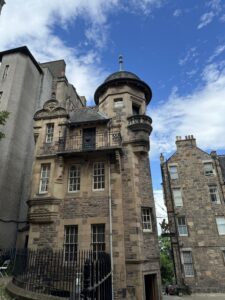Marginalised Writers of Edinburgh
Brighton Street
Frederick Douglass was an American social reformer and writer, his most famous work being “Narrative of the Life of Frederick Douglass, an American Slave”. He was born into slavery and was largely self-educated, rising to prominence as an abolitionist preacher after his first wife, Anna Murray, helped him escape his enslavers.
To preserve his freedom, Douglass was encouraged to tour Ireland and Britain, and spent two years lecturing in churches and chapels. One of these churches was the Evangelical Union Chapel at the end of Brighton Street, which has since been demolished. It’s existence can be seen on an old map of Edinburgh.

Douglass became a big proponent of the rise of the Scottish abolitionist movement, even being appointed “Scotland’s Antislavery Agent”. He largely succeeded in this role through inspiring national competition, arguing that support for abolition would prove Scotland’s moral superiority over England.
Douglass went on to have a very successful career as a writer and orator, delivering his famous speech “What to the Slave is the Fourth of July” in 1852, highlighting the hypocrisy and bigotry in the celebration of United States independence from British rule when 14% of its population was enslaved at the time.
George Square
Jane Welsh Carlyle lived at 23 George Square, and was widely regarded as an extraordinary letter writer, although she never published during her lifetime. In the 19th century, writing novels was a male-dominated pursuit, and women faced many barriers to doing so. Upon marrying, Welsh Carlyle led a traditional life and supported her husband in his writing pursuits. Her husband maintained that she would have become a successful novelist had she not married him.
Welsh Carlyle had a long friendship with novelist Geraldine Jewsbury, marked by an intimate correspondence. Despite their closeness, Welsh Carlyle and Jewsbury often had disagreements about women’s roles in marriage, with Jewsbury believing men and women should be equal. She saw how Welsh Carlyle’s husband acted towards his wife and often criticised him.
The writers both agreed that if one of them passed away, the other would destroy their letters. Upon Welsh Carlyle’s death, Jewsbury kept her promise and destroyed all of Jane’s letters. However, many of Jewsbury’s letters survived and reveal her passionate feelings for Welsh Carlyle, perhaps providing some clarity to her disapproval of the marriage.
Welsh Carlyle’s letters were first published posthumously in 1889, and have since been widely collected, with notable authors such as Virginia Woolf calling her one of the “great letter writers”.
The Grassmarket
Robert Louis Stevenson is one of the most famous Scottish authors, notably describing the Grassmarket in his novel “Kidnapped”. However, his cousin Dorothy E. Stevenson was a bestselling author in her own right.

D. E. Stevenson was born in 1892, great-granddaughter of the famous lighthouse builder Robert Stevenson. She grew up in the West End of Edinburgh, and fell in love with writing at a young age. However, her father disapproved and banned her from writing, later refusing to send her to university lest she become a “bluestocking” – an educated woman.
Despite these barriers, Stevenson continued to write in secret as a teenager hiding in the family attic. She published her first poetry book in 1915, and went on to author over 40 novels and poetry collections in her lifetime, selling over seven million copies.
Her cousin Robert Louis Stevenson is ranked as the 26th most translated author in the world. Although D. E. Stevenson did not achieve the same acclaim, her books have been translated into seven languages, including braille. They were at the top of bestselling lists in Britain, South Africa and Australia.
This is all the more impressive, considering Stevenson never received a formal education, and faced so many obstructions to her writing. However, she always stated that writing was in her blood, and that her books were her “lighthouses”. Today, Stevenson still has a large following in the USA, with her fans calling themselves “Dessies” or “DESsies”.
Lady Stair’s Close
Robert Burns is Scotland’s bard, known across the world for his poetry and songs. His life and works are celebrated in the Writers’ Museum at Lady Stair’s Close, alongside Sir Walter Scott and Robert Louis Stevenson. However, there was another famous author, born in Lady Stair’s Close, who is only briefly mentioned in the museum.

Susan Ferrier was a successful novelist, born in 1782. She wrote vivid portrayals of Scottish life and women’s education, with her novels set in Edinburgh and the Highlands. Like Burns, Ferrier often wrote in Scots, aiming to create a believable depiction of her worldly experience. This was distinctive at the time, with many intellectuals attempting to rid their work and speech of Scots.
Ferrier authored three novels in her lifetime: “Marriage”, “The Inheritance”, and “Destiny”. Her brother secured the money for her novels instead of Ferrier, demonstrating the financial dependence of women at the time, even when they had established careers. Ferrier’s last book was sold for an astonishing £115,000 in today’s money.
Ferrier was later dubbed “Scotland’s Jane Austen”, although she is far lesser known – despite her novels outselling Austen’s in the 19th century. She published anonymously, as did Austen, because it was not considered appropriate for women to have a public role in Victorian society.
Ferrier’s novels declined in popularity throughout the 20th century, however several famous authors such as Val McDermid are trying to revive her memory.
This was an excerpt from Katherine Scott and Katie Grieve’s book, “Edinburgh Historic Walks: A Summary of Hidden Histories”.


